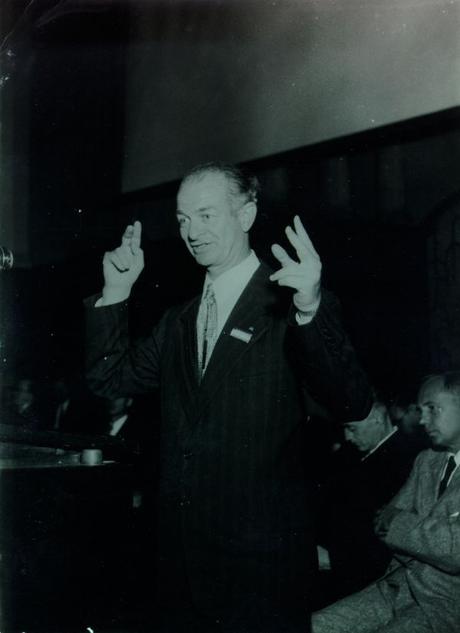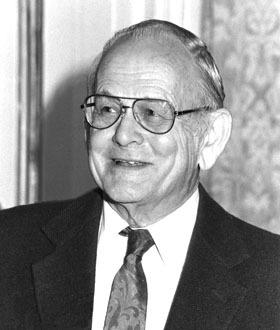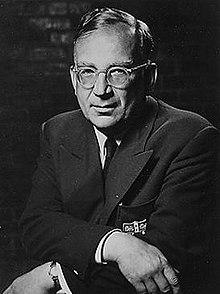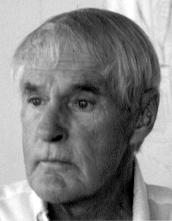 Linus Pauling, 1950s
Linus Pauling, 1950s[Pauling and the Guggenheim Foundation]
During the years of Linus Pauling’s association with the John Simon Guggenheim Memorial Foundation, many high profile individuals were awarded fellowships. The year 1951, for instance, saw Rachel Carson of the United States Fish and Wildlife Service – and future author of the environmental classic Silent Spring – awarded $3,000 for a one-year study of the ecology of Atlantic coast animals. That same year, the experimental poet e. e. cummings received $3,000 to support his creative writing. Though in many cases Pauling’s only involvement was as a voter, he occasionally spoke to or was in contact with people who had achieved or would gain wider recognition.

In 1952 Henry Allen Moe, the Foundation’s Secretary, was looking for an assistant to help him comb through Fellowship applications. One person he had in mind was Garrett Hardin, a biologist at the Santa Barbara College of the University of California. During his tenure at Santa Barbara, Hardin had focused on improving the school’s biology curriculum. Partly as a result of this work, Hardin authored an extremely successful textbook titled Biology: Its Human Implications that was earning him some $10,000 per year in royalties.
Moe feared that the financial windfall from the biology text would put Hardin in a position to turn down any offers to leave California and devote time to tasks outside of revising and updating his book. Regardless, Moe wanted Pauling to interview Hardin and then supply his opinion on whether or not the biologist would be a good fit for the Foundation. Hardin had applied for a Fellowship that year, and Moe suggested that Pauling use this as a pretense for the interview. Moe also wanted Pauling and Ava Helen to visit as a couple with Hardin and his wife Jane to help round out a fuller and clearer impression. Pauling was advised that he could treat the trip as a vacation for which he would be reimbursed by the Foundation.
Pauling agreed to the task, noting that he did not need the Foundation to pay for his trip since he already had a funded visit to Ventura County on the calendar, to be sponsored by a high school teachers group. After meeting with the teachers, Pauling spoke with Hardin and stayed overnight, something he would have ended up doing anyway since a large storm had come in.
Having completed his trip, Pauling reported that he did not think Hardin would be a good candidate to assist Moe, nor even a good candidate for a Fellowship. According to Pauling, Hardin was “too helter-skelter in his actions, and probably also in his thinking” to work well as an assistant. And while he appeared to form good solid opinions of others, Pauling harbored doubts about Hardin’s thoroughness, a quality of high importance for Moe’s assistants.
Pauling’s main objection to Hardin’s Fellowship application was that the plan that it outlined was too weak. In his proposal, Hardin indicated a desire to “harmonize” the disagreement between R. A. Fischer and Sewall Wright’s dueling interpretations of Theodosius Dobzhansky’s work on population genetics. Wright thought that Dobzhansky’s views supported his own “shifting balance” theory, which posited that random genetic drift could overcome the stability of isolated populations created by natural selection. Fischer disagreed with this notion.
When Pauling pressed Hardin to explain how he would harmonize the opposing viewpoints, Hardin apparently lost his nerve and admitted to an incomplete understanding of Wright and Dobzhansky’s positions. Hardin further disappointed Pauling when he criticized George Gaylord Simpson’s books on evolution by saying that they had many mistakes in them, without qualifying that Simpson was a very good paleontologist and popular science writer. A week after Pauling submitted his report, Moe replied that he and Associate Secretary James F. Mathias had been admiring Pauling’s letter as a “complete, and completely perfect, communication” that told them all they needed to know and more.
While he was neither offered the assistant position nor a Fellowship, Garrett Hardin went on to become a popular, if controversial, science writer. Of particular note was his 1968 book The Tragedy of the Commons, which addressed overpopulation as moral rather than a technological problem. Many of his subsequent books amplified this position.

In 1952, after twelve years of service, Pauling rotated off of the Committee of Selection, but Moe continued to request his input on certain applicants, especially for those individuals working on research close to his own. In one instance, when solicited in 1956, Pauling thought there was “no doubt” that Columbia University biochemist Erwin Chargaff deserved another Guggenheim to extend his recent work with DNA.
The following year, Pauling took a contrary view in recommending against George Washington University physicist and cosmologist George Gamow, who was working on protein synthesis. Though he had spent little time studying protein structure, Gamow sought funding for a trip to England to learn more about it with Frederick Sanger and Francis Crick. Pauling did not imagine that Sanger and Crick particularly wanted Gamow to make the visit and did not expect Gamow to make a substantial contribution to the field. For Pauling, the small number of papers that Gamow had already published on the topic did not say anything especially new and were unlikely to stand up once all the open questions had been settled.
Pauling considered Gamow to be a very good popular science writer, but not a top-tier scientist in any sense. This assessment was surely colored by a personal exchange wherein Gamow sent Pauling a manuscript that he intended to publish on protein structures the put forth ideas very similar to those formulated by Pauling and Robert Corey. In going through the paper, Pauling found a flaw in Gamow’s argument that threw off his numbers. But when Pauling wrote him about it, not only did Gamow fail to respond, he later published the manuscript without taking Pauling’s criticism into account.

Another applicant whom Moe asked Pauling to review was psychologist Timothy Leary, who submitted a proposal in 1959. While on faculty at Harvard, Leary began working with Richard Alpert to research the psychological effects of psilocybin, a potential overlap with Pauling’s interests in the biochemical basis of mental diseases.
Moe passed the application along to Pauling telling him that others had already looked it over, at which point Pauling saw that one literary critic had called it “horrible!” and a psychologist had dismissed the ideas as “pseudo-science.” Moe and board member E. B. Wilson were not so sure and wanted Pauling’s open mind to provide an opinion. If Pauling thought it necessary, Moe told him he should meet with Leary in person.
Pauling quickly decided that a meeting would not be necessary. Though the plan was very original, Pauling did not think it had much chance of going anywhere were it funded. That said, Pauling also admitted that his ignorance of some of the subject matter had the potential to obscure any of the possibilities and so made no formal recommendation either way. Moe appreciated Pauling looking at Leary’s application and figured he was “chasing the wrong hunch.” In the end, Leary and Alpert carried out their research without support from the Guggenheim Foundation but had their project shut down by Harvard in 1963. Soon afterward, Leary became a prominent figure promoting the use of psychedelics.
Linus Pauling’s association with the Guggenheim Foundation provided him with a great many opportunities to meet and learn about a wide array of people whom he would not otherwise have known. That Henry Allen Moe turned to Pauling for his opinion on such a diverse group of people, including several who worked outside of Pauling’s areas of expertise, is indicative of the high value that Moe placed on Pauling’s judgments.
